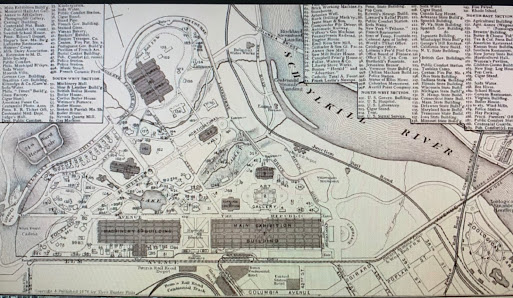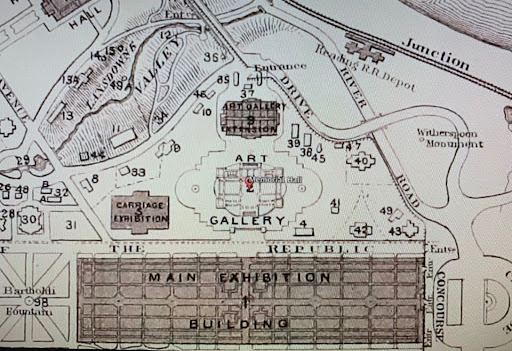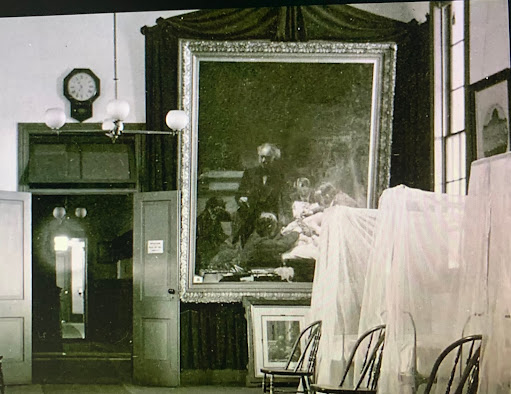 |
| The Gross Clinic, 1875 Thomas Eakins |
The presenter for the series is Paul Glenshaw.
Glenshaw is an artist, educator, author, and filmmaker with more than 25 years experience working across disciplines in the arts, history, and sciences. He teaches drawing for Smithsonian Associates and studied painting at Washington University in St. Louis.
The presentation began with the story of the painting's first showing. It was first exhibited at the Centennial International Exhibition which, according to Wikipedia, was "... the first official World's Fair in the United States" and "was held in Philadelphia, Pennsylvania from May 10 to November 10, 1876, to celebrate the 100th anniversary of the signing of the Declaration of Independence in Philadelphia."
 |
| Centennial International Exhibition |
This was a very important event for the US to show the world that the Civil War, which had ended 11 years earlier, had not dulled the accomplishments or capabilities of the nation. It was an opportunity, as Paul said, "to bring the world in and show off."
The Eakins family was very interested in the art on show at the Exhibition as Thomas had submitted four pieces, the largest of which, they were sure, was going to be a knockout. They traversed the main exhibition hall on opening day but the painting was nowhere to be found. "The young and little-known Eakins created it specifically for Philadelphia's 1876 Centennial Exhibition, intending to showcase his talents asa n artist and to honor the scientific achievements of his native Philadelphia."
Eakins eventually asked after the painting and was directed to a small Army building, somewhat removed from the main exhibition area, where items from a military hospital were on display. The painting was hung in a corner in this building.
We have no record of Eakins' response to the placement of his "masterpiece."
Let us step back into the past and explore Eakins' background. Thomas Eakins was born on July 25, 1844 in Philadelphia, PA, and, except for relatively short periods, he lived most of his life in that city. He was the oldest of four living children (three sisters). His father was a writing master and trained Thomas in that trade. He attended Central High School where he was a curious and brilliant student. While there he became enthralled with drawing and perspective.
After graduation he was torn between art and medicine. He studied painting and drawing at the Pennsylvania Academy while also taking classes at the medical school as preparation for becoming a Doctor. He made a decision in 1866: he would devote himself to art.
He traveled to Paris in 1866 and ended up in the Atelier of Jean-Leon Gerome. This was a very satisfying outcome for Eakins as, in Gerome, he found someone who took him seriously and someone he could take seriously.
Eakins ended up spending four years in Europe, including time spent in Rome and Madrid. His real artistic revelation came with his trip to Spain. He felt that the Spanish artists -- he became a huge fan of Ribera and Velasquez -- spoke to him personally and that their works were things that he could seek to emulate.
His first attempts at painting occurred while he was in Spain.
But he truly began to blossom and improve upon his return to Philadelphia.
Doctor S.D. Gross entered Jefferson Medical College as a member of its second class. Upon graduation he left Philadelphia for 20 years but came back as a Professor at his alma mater where he eventually became Chief of Surgery.
Dr. Samuel Gross was one of the nation's leading surgeons before and during the war ... his reputation as a leading medical educator was unparalleled.
 |
| Dr Samuel Gross |
Returning to Eakins, Glenshaw noted that he painted what he saw, he had a dedicated eye to realism.
The setting for the painting was the Surgical Theater at the Medical College and the surgery was being conducted on a patient suffering from Osteomyelitis. With the exception of the boy's mother, and an assistant, all of the surrounding faces are visible and are portraits of actual persons. The focal points of the painting, however, are the bloodied hands of Dr. Gross and the surgical wound on the patient's leg. The hand holding the scalpel is finely detailed.
 |
| The Gross Clinic, 1875 Thomas Eakins |
According to columbiasurgery.org, this painting "is regarded as one of the most significant American paintings ever made" and "is an important marker in the history of medicine and in the emergence of surgery as a method of healing, not just the reality of amputation."
The Philadelphia Museum of Art described it thusly (columbiasurgery.org): "The subject shocked viewers unused to seeing such a frightening event depicted in such realistic detail. Bright red blood colors the surgeon's fingers and scalpel, and the gaping incision is fascinating, repulsive, and confusing because it is so hard to read the position of the patient's body. Although some viewers admired Eakins's command of composition, color, and detail, and praised his convincing creation of form and space, many were repelled by what was considered ugly and inartistic realism."
Eakins had been sure that his painting was going to be a hit. It was not. At the close of the exhibition, the Jefferson Medical College bought it for $200 and it remained at the institution until the Board of Jefferson University voted to sell it for $68 million to the National Gallery of Art and The Crystal Bridge Museum of American Art. After a flurry of activity, the goal of keeping the painting in the City of Philadelphia was attained when it was purchased by the Philadelphia Museum of Art and the Pennsylvania Academy of Fine Arts.
 |
| Glenshaw and his son alongside the painting at the Philadelphia Museum of Art |
©EverythingElse238




















No comments:
Post a Comment